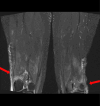Dasatinib-Induced Polymyositis-Like Syndrome: A Report of a Rare Case
- PMID: 40693085
- PMCID: PMC12277042
- DOI: 10.7759/cureus.86457
Dasatinib-Induced Polymyositis-Like Syndrome: A Report of a Rare Case
Abstract
Myositis is an inflammatory muscle disease characterized by chronic inflammation, progressive muscle weakness, and various systemic effects. Dasatinib, a tyrosine kinase inhibitor (TKI), is commonly used as a first-line treatment for chronic myelogenous leukemia (CML). Although it is generally effective, there have been rare cases where dasatinib can induce muscle damage, leading to muscle weakness. We wanted to highlight a unique case involving a 24-year-old Caucasian male who was treated with dasatinib for CML and subsequently developed proximal weakness in both his upper and lower extremities. Imaging studies, including multiple MRI scans, revealed diffuse muscular edema. Importantly, the patient did not receive steroid treatment; however, his symptoms significantly improved after discontinuing dasatinib. This case is a noteworthy contribution to the understanding of dasatinib-induced polymyositis-like syndrome, as it represents the first documented instance, to the best of our knowledge, based on our literature review. Such cases emphasize the need for close monitoring of muscle health in patients receiving dasatinib and encourage further investigation into the relationship between this medication and myositis.
Keywords: dasatinib; drug-induced myositis; inflammatory myopathy; muscle inflammation; myositis; rheumatology.
Copyright © 2025, Kulkarni et al.
Conflict of interest statement
Human subjects: Informed consent for treatment and open access publication was obtained or waived by all participants in this study. Conflicts of interest: In compliance with the ICMJE uniform disclosure form, all authors declare the following: Payment/services info: All authors have declared that no financial support was received from any organization for the submitted work. Financial relationships: All authors have declared that they have no financial relationships at present or within the previous three years with any organizations that might have an interest in the submitted work. Other relationships: All authors have declared that there are no other relationships or activities that could appear to have influenced the submitted work.
Figures



Similar articles
-
The Black Book of Psychotropic Dosing and Monitoring.Psychopharmacol Bull. 2024 Jul 8;54(3):8-59. Psychopharmacol Bull. 2024. PMID: 38993656 Free PMC article. Review.
-
A systematic review of adult-onset clinically amyopathic dermatomyositis (dermatomyositis siné myositis): a missing link within the spectrum of the idiopathic inflammatory myopathies.J Am Acad Dermatol. 2006 Apr;54(4):597-613. doi: 10.1016/j.jaad.2005.10.041. Epub 2006 Jan 23. J Am Acad Dermatol. 2006. PMID: 16546580
-
Systemic pharmacological treatments for chronic plaque psoriasis: a network meta-analysis.Cochrane Database Syst Rev. 2021 Apr 19;4(4):CD011535. doi: 10.1002/14651858.CD011535.pub4. Cochrane Database Syst Rev. 2021. Update in: Cochrane Database Syst Rev. 2022 May 23;5:CD011535. doi: 10.1002/14651858.CD011535.pub5. PMID: 33871055 Free PMC article. Updated.
-
Interventions for dysphagia in long-term, progressive muscle disease.Cochrane Database Syst Rev. 2016 Feb 9;2(2):CD004303. doi: 10.1002/14651858.CD004303.pub4. Cochrane Database Syst Rev. 2016. PMID: 26859621 Free PMC article.
-
Severe Relapsing Hailey-Hailey Disease Displaying a Durable Complete Response to Hydroxyurea.Acta Dermatovenerol Croat. 2024 Nov;32(3):168-169. Acta Dermatovenerol Croat. 2024. PMID: 40654217
References
Publication types
LinkOut - more resources
Full Text Sources
